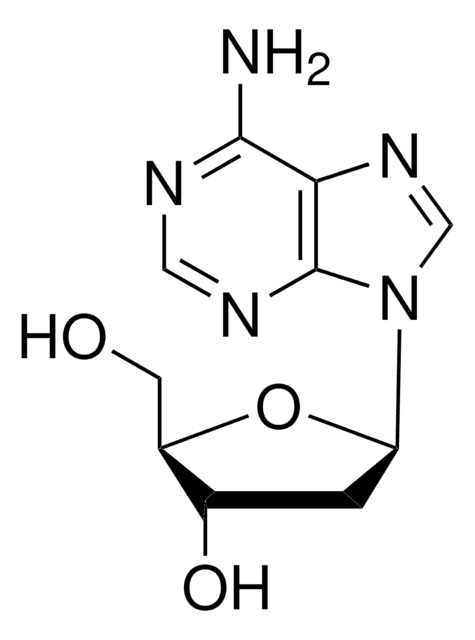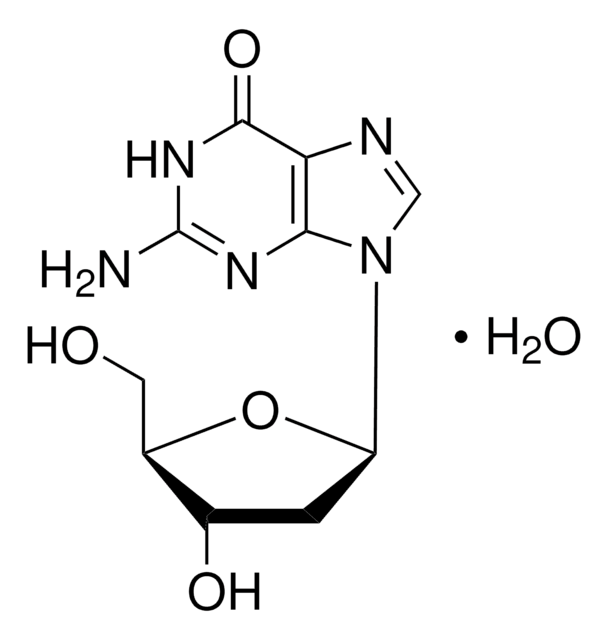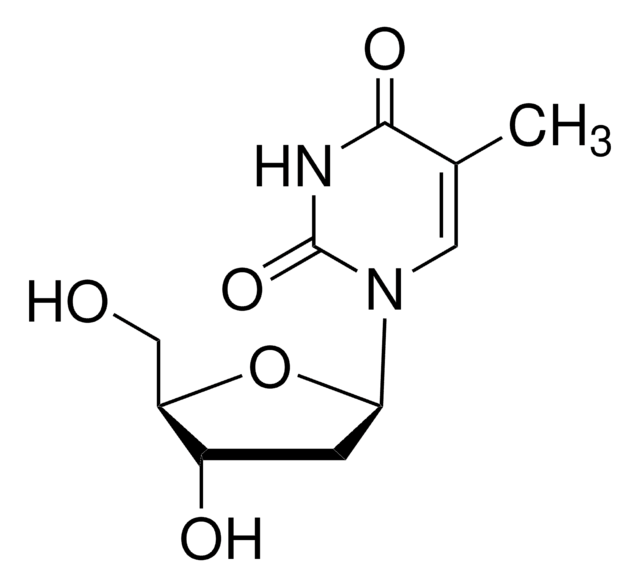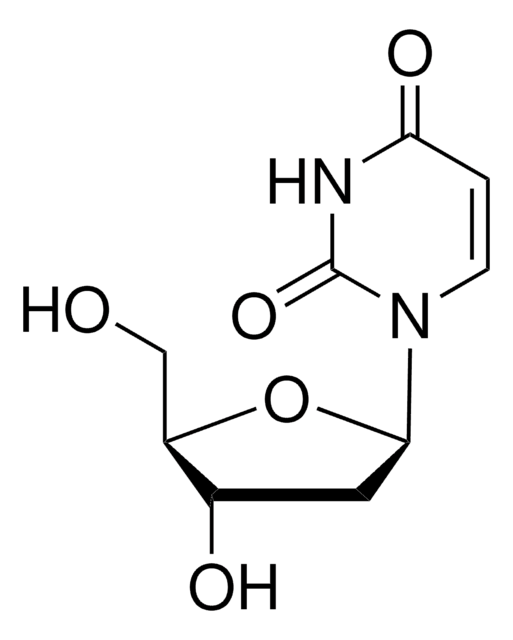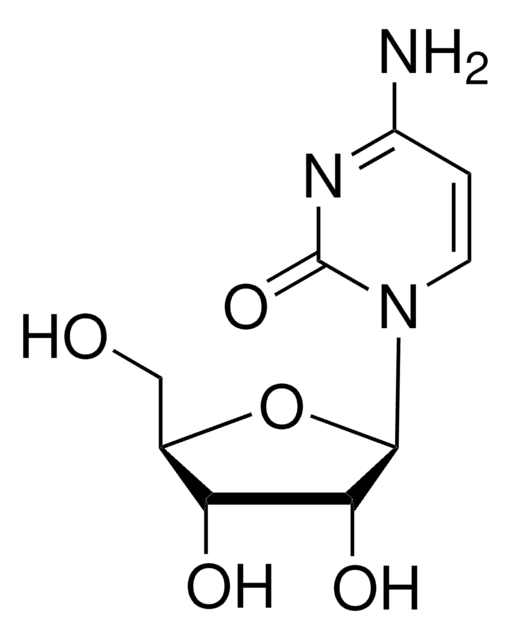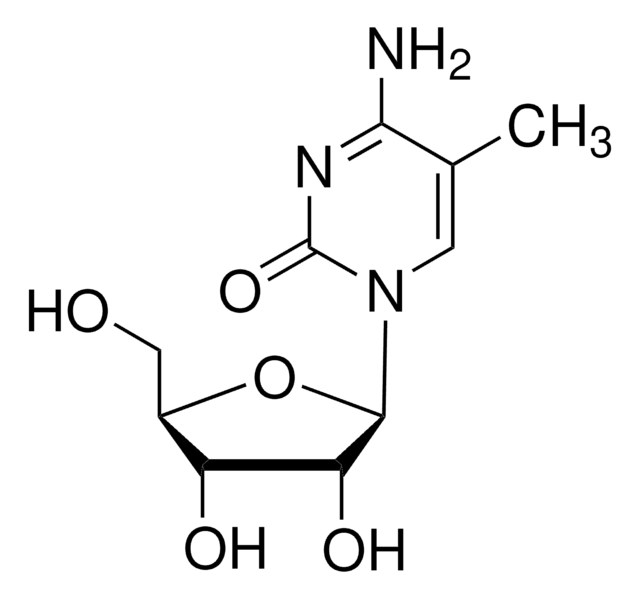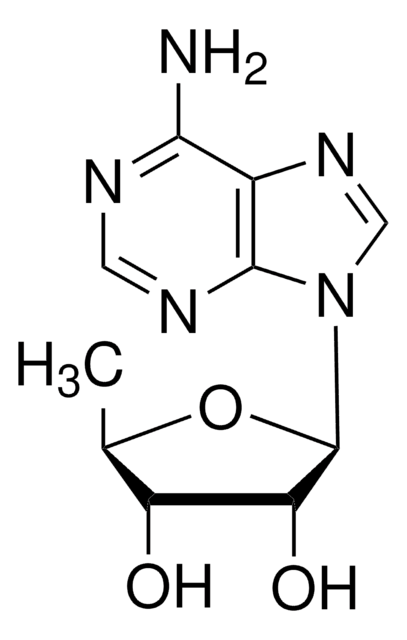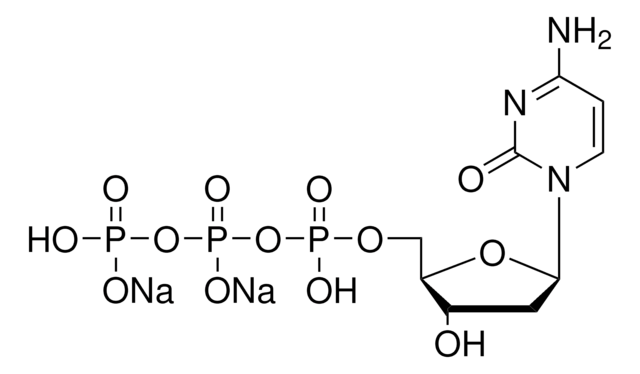추천 제품
생물학적 소스
synthetic (organic)
Quality Level
분석
≥99% (HPLC)
양식
powder
solubility
water: 50 mg/mL, clear, colorless to very faintly yellow
저장 온도
−20°C
SMILES string
NC1=NC(=O)N(C=C1)[C@H]2C[C@H](O)[C@@H](CO)O2
InChI
1S/C9H13N3O4/c10-7-1-2-12(9(15)11-7)8-3-5(14)6(4-13)16-8/h1-2,5-6,8,13-14H,3-4H2,(H2,10,11,15)/t5-,6+,8+/m0/s1
InChI key
CKTSBUTUHBMZGZ-SHYZEUOFSA-N
일반 설명
2′-Deoxycytidine (deoxyC) is one of the deoxynucleosides containing cytosine as the nucleobase. It is found in the blood, feces, and urine.
애플리케이션
2′-Deoxycytidine has been used:
- as a substrate for Trypanosoma brucei cytidine deaminase (TbCDA) to measure its activity
- as a standard in the isolation and quantification of metabolite levels in murine tumor interstitial fluid by liquid chromatography-mass spectrometry (LC–MS)
- to study the role of autophagy in response to oncogenes and DNA replication stress
생화학적/생리학적 작용
2′-Deoxycytidine (deoxyC) forms dCTP upon phosphorylation which is used to synthesis DNA via various DNA polymerases or reverse transcriptases. DeoxyC is the substrate for deoxycytidine deaminase (EC 3.5.4.14) which converts it into 2′-deoxyuridine. DeoxyC is phosphorylated to the nucleotide dCMP by the enzyme deoxycytidine kinase (DCK). DeoxyC serves as a potential head and neck cancer marker.
Storage Class Code
11 - Combustible Solids
WGK
WGK 3
Flash Point (°F)
Not applicable
Flash Point (°C)
Not applicable
개인 보호 장비
Eyeshields, Gloves, type N95 (US)
이미 열람한 고객
Hiroya Murakami et al.
Talanta, 177, 12-17 (2017-11-08)
Acetaldehyde (AA), which is present in tobacco smoke, automobile exhaust gases and alcohol beverage, is a mutagen and carcinogen. AA reacts with 2'-deoxyguanosine (dG) in DNA to form N
Martyna Modrzejewska et al.
Free radical biology & medicine, 101, 378-383 (2016-11-12)
The most plausible mechanism behind active demethylation of 5-methylcytosine involves TET proteins which participate in oxidation of 5-methylcytosine to 5-hydroxymethylcytosine; the latter is further oxidized to 5-formylcytosine and 5-carboxycytosine. 5-Hydroxymethyluracil can be also generated from thymine in a TET-catalyzed process.
Annika R Seddon et al.
Epigenetics & chromatin, 14(1), 17-17 (2021-03-26)
Environmental factors, such as oxidative stress, have the potential to modify the epigenetic landscape of cells. We have previously shown that DNA methyltransferase (DNMT) activity can be inhibited by sublethal doses of hydrogen peroxide (H2O2). However, site-specific changes in DNA
Santiago Uribe-Lewis et al.
Genome biology, 16, 69-69 (2015-04-09)
The discovery of cytosine hydroxymethylation (5hmC) as a mechanism that potentially controls DNA methylation changes typical of neoplasia prompted us to investigate its behaviour in colon cancer. 5hmC is globally reduced in proliferating cells such as colon tumours and the
E Mini et al.
Annals of oncology : official journal of the European Society for Medical Oncology, 17 Suppl 5, v7-12 (2006-06-30)
Gemcitabine (2',2'-difluoro 2'-deoxycytidine, dFdC) is the most important cytidine analogue developed since cytosine arabinoside (Ara-C). The evidence of its potent antitumor activity in a wide spectrum of in vitro and in vivo tumor models has been successfully confirmed in the
자사의 과학자팀은 생명 과학, 재료 과학, 화학 합성, 크로마토그래피, 분석 및 기타 많은 영역을 포함한 모든 과학 분야에 경험이 있습니다..
고객지원팀으로 연락바랍니다.